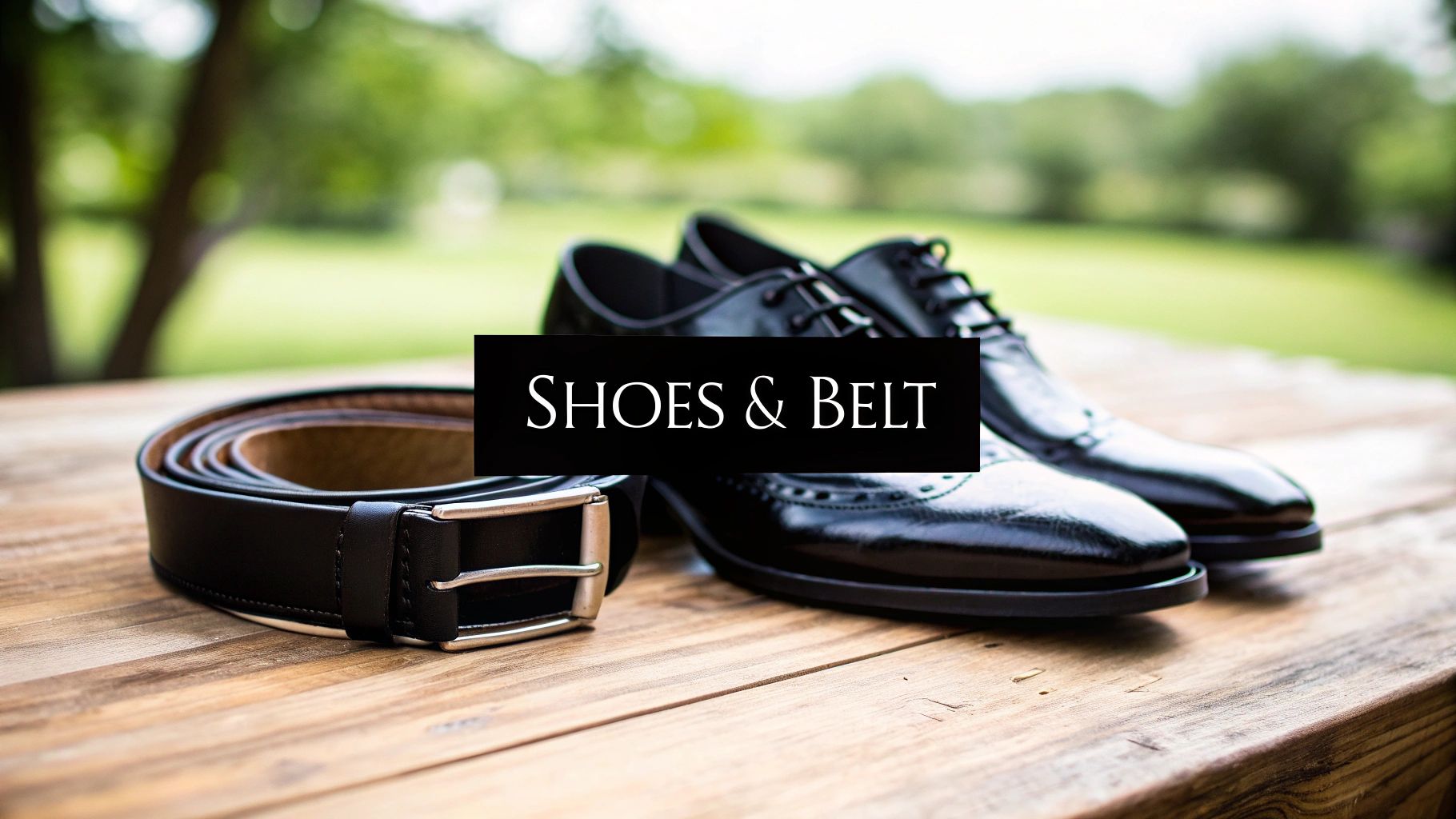
Your Guide to the Perfect Tuxedo Bow Tie Shirt
Let's be clear: the tuxedo shirt isn't just a placeholder under your jacket. It's the critical foundation of any black-tie outfit, the crisp canvas that makes your bow tie and lapels truly pop. A proper tuxedo bow tie shirt is a world away from your everyday office button-down, defined by specific, non-negotiable details that signal true formal elegance for any men's suit ensemble.
The Anatomy of a Flawless Tuxedo Shirt
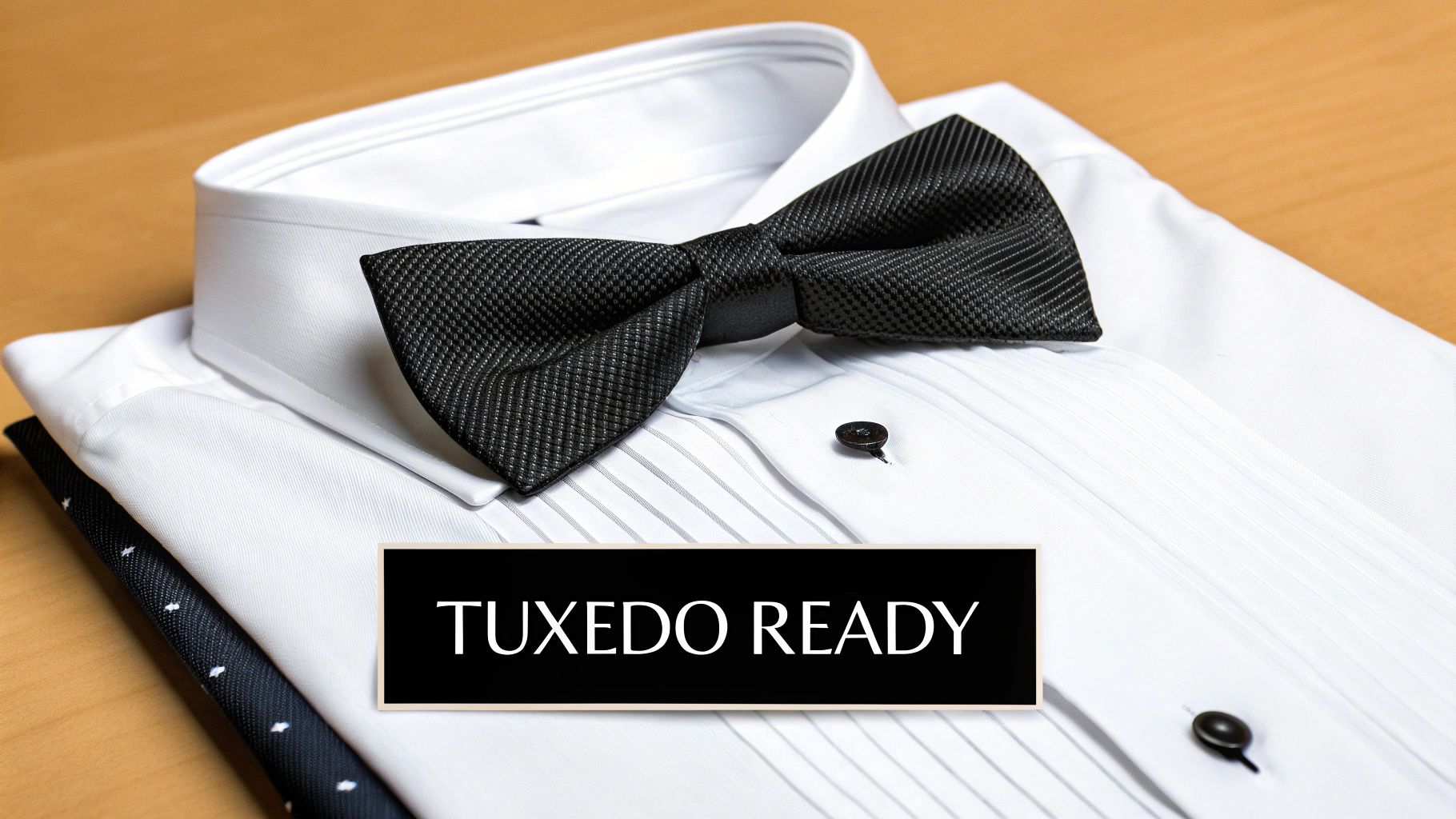
Before you can nail the look, you have to understand what separates a genuine tuxedo shirt from a standard dress shirt. It's not just about the color. The entire garment is constructed to complement the sharp structure and refined feel of a tuxedo, whether it's a classic two-piece with peak lapels or a full three-piece men's suit.
Get this part right, and every other element—from your bow tie to your cufflinks—falls perfectly into place. And it's a detail worth mastering. Formal events are back in a big way, a trend reflected in the global tuxedo rental market, which was valued at around USD 3.8 billion and is projected to hit USD 5.7 billion by 2033. North America is leading the charge, holding over 42% of the market share. People care about getting dressed up again.
Defining Features of a Tuxedo Shirt
So, what are the tell-tale signs of a real tuxedo shirt? A few key components are mandatory. These are the details designed to work in perfect harmony with your tuxedo jacket, whether you're wearing a classic single-breasted model with a single button or a modern velvet dinner jacket with a shawl collar.
Here’s what to look for:
- Specialized Collars: You'll typically see a Wing Tip collar for ultra-formal events or the more versatile Spread collar. Both are shaped specifically to frame a bow tie, not a necktie.
- French Cuffs: This is a big one. These double cuffs are folded back on themselves and secured with cufflinks. Standard barrel cuffs simply won't cut it for a black-tie men's suit.
- Distinctive Plackets: The front of the shirt where the buttons are is also unique. A formal placket is designed for elegant studs, or it might feature a "fly front" that hides the buttons completely for an exceptionally clean, minimalist look.
A well-chosen tuxedo shirt does more than just fill the space under your jacket—it actively enhances it. The crispness of the fabric and the sharpness of the collar are fundamental to achieving that iconic, put-together formal appearance with any two-piece or three-piece tuxedo.
Getting these specifics right is what separates the men from the boys in formalwear. This classic white slim-fit tuxedo shirt is a perfect example, combining all the essential elements for a flawless look.
Tuxedo Shirt vs Dress Shirt Key Differences
To make it even clearer, let's break down the core differences. While they might both be white shirts, their purpose and construction are miles apart.
| Feature | Proper Tuxedo Shirt | Standard Dress Shirt |
|---|---|---|
| Collar | Designed for bow ties (Wing Tip, Spread) | Versatile for neckties (Point, Cutaway) |
| Cuffs | French Cuffs requiring cufflinks | Barrel Cuffs with buttons |
| Placket | Accepts studs or has a hidden "fly front" | Standard button-up placket |
| Bib | Often features a pleated or piqué bib for texture/formality | Usually a plain front |
| Fabric | Typically high-quality cotton (Broadcloth, Piqué, Twill) | Can be cotton, linen, or synthetic blends |
| Primary Use | Black-tie events with a two-piece or three-piece tuxedo | Business, casual, and semi-formal wear with a men's suit |
As you can see, every detail of a tuxedo shirt is intentionally designed for a formal setting. Choosing a standard dress shirt for a black-tie event is a common mistake that instantly undermines the entire outfit.
Choosing the Right Collar for Your Bow Tie
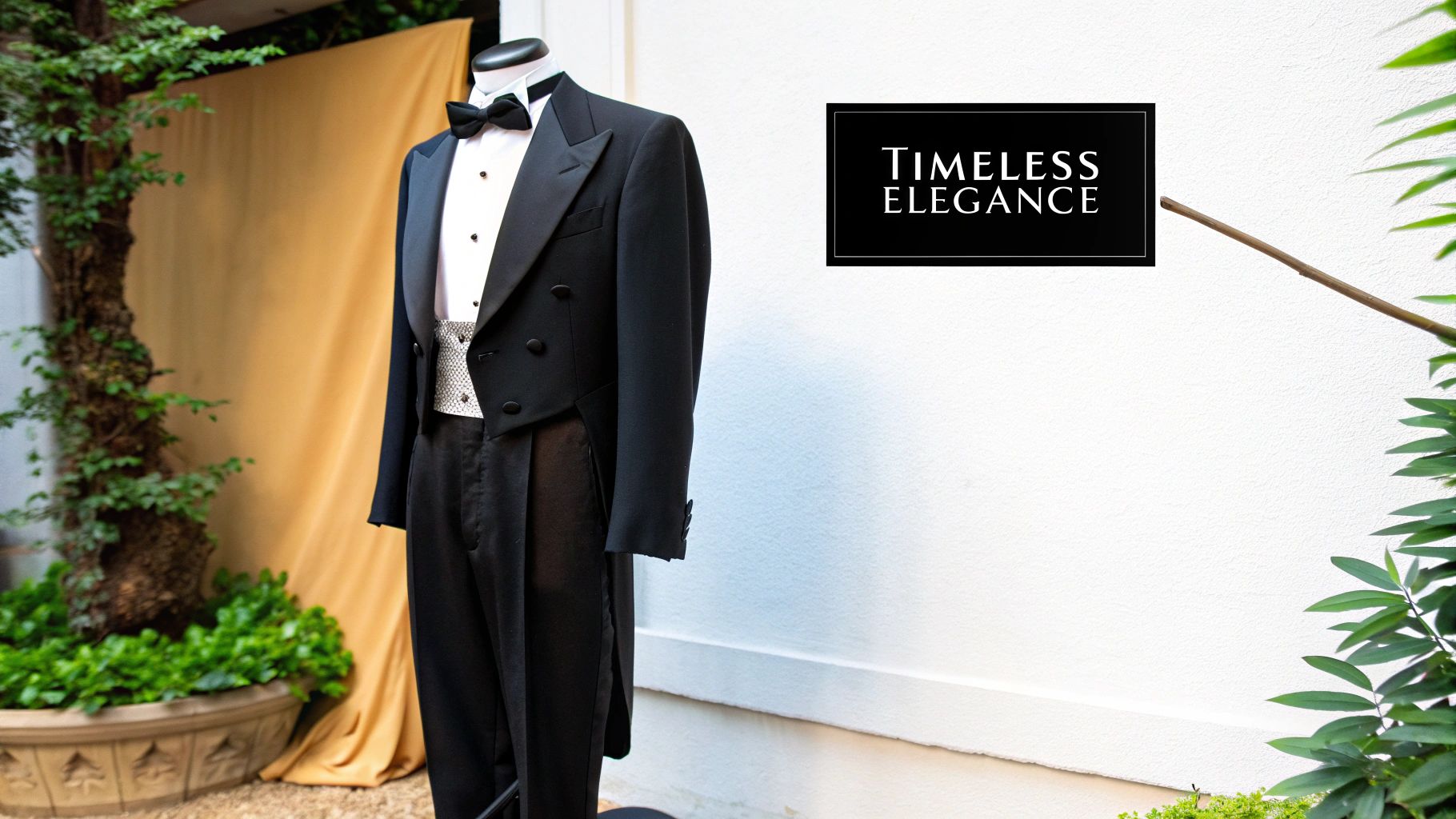
The collar of your tuxedo shirt does more than just hold things together—it’s the frame for your bow tie. Think of it as the main stage. Get this part wrong, and the whole look can feel unbalanced and just… off. A great collar gives your bow tie the support it needs, making sure it pops against that crisp white fabric.
So, which collar is the one? It really comes down to the formality of the event and the specific tuxedo you've picked out. If you're heading to a strict white-tie gala and wearing a formal men's tailcoat tuxedo, one collar style reigns supreme.
The Traditional Wing Tip Collar
For the absolute height of formality, nothing beats the wing tip collar. It gets its name from those two small, stiff points that fold down and stick out, almost like little wings. They're specifically designed to be tucked neatly behind the band of your bow tie.
This creates an incredibly clean, classic silhouette that takes you right back to the golden age of formalwear. It’s the definitive choice for those pinnacle black-tie events. If your go-to is a classic single-breasted tuxedo with satin peak lapels and a single button, a wing tip collar shirt is the perfect finishing touch for that timeless, polished look.
The Modern Spread Collar
Looking for something a bit more contemporary and versatile? The spread collar is a fantastic pick. The points of this collar are set further apart, which creates a more open look that flatters just about every face shape. It’s a workhorse—looking just as sharp with a modern two-piece tuxedo as it does with a more layered three-piece men's suit that includes a vest.
This versatility has made it a go-to for many guys. It also plays well with all sorts of bow tie knots, whether you prefer a sleek butterfly or a fuller batwing style. This shift reflects bigger trends, too. The global bow ties market was estimated at USD 1.84 billion, with the classic self-tie style holding a commanding 40% share of revenue. You can dig into the numbers in this bow tie market analysis.
Whichever style you land on, make sure the collar itself is well-made and firm. A flimsy, weak collar will start to sag under the weight of a bow tie as the night wears on, and that will kill the sharp lines of your entire outfit.
Decoding Shirt Fronts: Pleats and Plackets
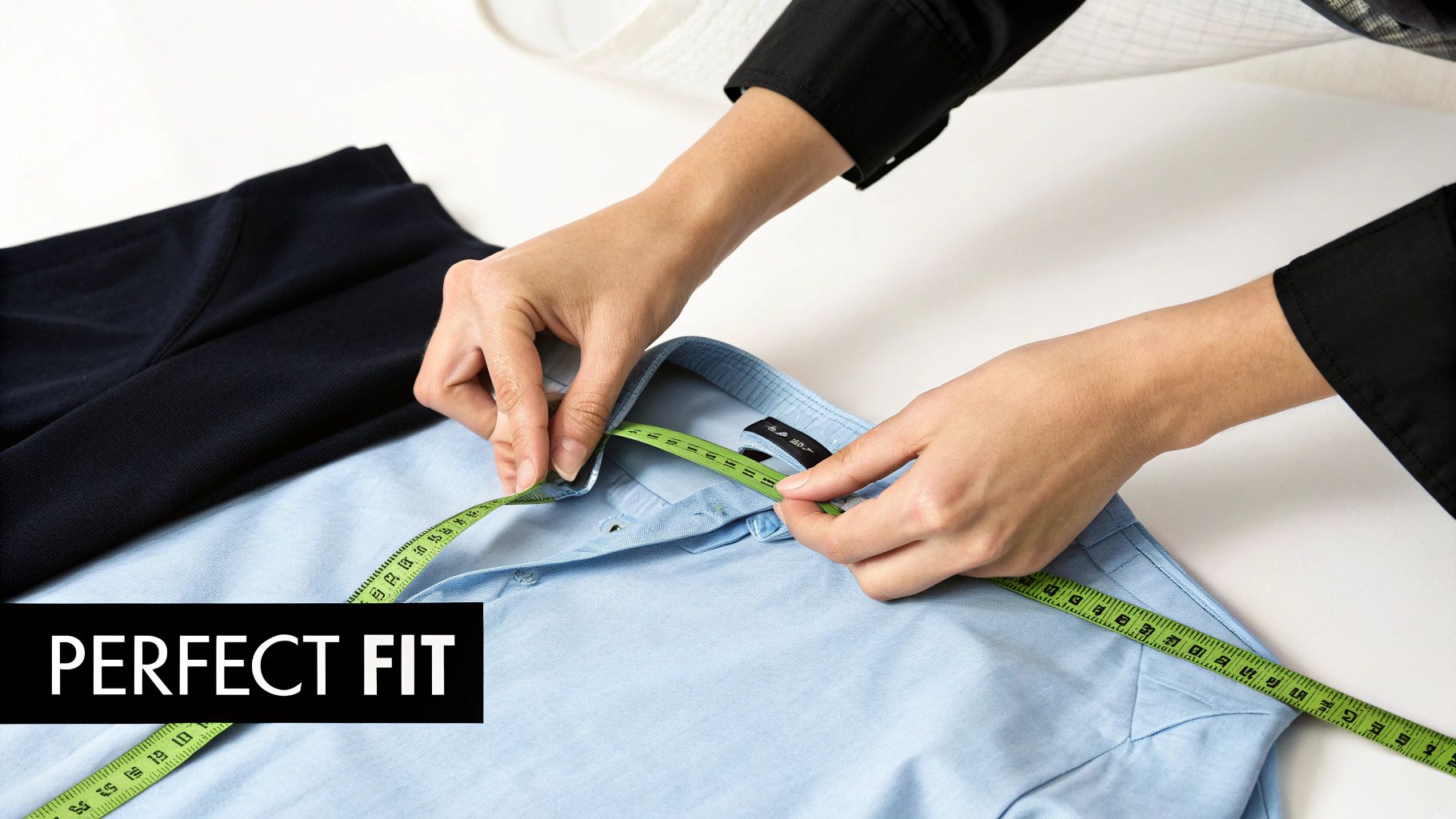
The front of your tuxedo bow tie shirt—what we call the bib—is your main stage. This is where you get to play with texture and really dial in the personality of your look, pushing it toward classic formality or sharp, modern minimalism. What you choose here sets the tone for the entire outfit.
Think about it this way: a classic single-breasted two-piece tuxedo with sleek peak lapels and a single button closure just screams for a traditional shirt. The hands-down best choice is a front with narrow pin-tuck pleats. Those subtle vertical folds are the calling card of timeless black-tie elegance.
Piqué vs. Plain Fronts
But pleats aren't your only option. For a different kind of texture, the piqué bib is a fantastic alternative. This style has a stiffer front panel with a distinct, almost geometric waffle-like weave. It's just as formal as pleats but brings a unique character that pairs exceptionally well with the smooth, rounded shawl collar on a two-piece tuxedo.
On the other end of the spectrum is the plain front. It’s clean, crisp, and unapologetically minimalist. This is your go-to when you're aiming for a streamlined, modern aesthetic—the perfect partner for a slim-fit, two-piece tuxedo when you want to look razor-sharp.
The shirt front isn't just fabric; it's an architectural detail. Your choice of a pleated, piqué, or plain front should complement the lapels, buttons, and overall cut of your specific tuxedo jacket.
The Critical Role of the Placket
Let's talk about the placket—that strip of fabric where the buttons live. It’s a small detail, but it’s crucial for getting the look right. How you fasten the shirt adds that final layer of polish, and for a proper tuxedo shirt, you really have two main paths.
A traditional placket is built with extra buttonholes specifically for studs. This lets you bring in handsome mother-of-pearl or onyx studs, creating a cohesive look by matching them to your cufflinks. It’s a classic, can't-miss choice.
If you’re all about that clean, modern vibe, the fly front placket is for you. A hidden flap of fabric conceals the buttons entirely, creating a smooth, uninterrupted line down your torso. This is an incredible look, especially with a three-piece tuxedo where the vest covers part of the shirt, making the canvas behind the vest and jacket pristine.
Finding the Perfect Fabric and Fit
A great tuxedo shirt isn't just about the collar style or the pleats. It's the small, tangible details—the feel of the fabric and the precision of the cut—that truly separate a quality garment from something you’ll wear once and forget. These are the things that keep you comfortable and looking sharp from the first photo to the last dance.
When it comes to fabric, there's a reason seasoned pros stick with premium cottons. They breathe well under a heavy two-piece or three-piece tuxedo jacket and hold their crisp shape all night. You can’t go wrong with classic choices like smooth Broadcloth or a lightweight Poplin, which both offer a clean, refined look.
If you want something with a bit more character, look into Royal Oxford. Its weave has a subtle texture that adds a touch of visual interest without being loud or distracting.
A well-made shirt is part of a much larger picture. The global neckwear market, which includes essentials like bow ties, was valued at USD 3,743.2 million and is on track to hit USD 4,465.4 million by 2030. You can see more in this detailed neckwear market report.
Nailing the Perfect Fit
Getting the fit right is absolutely crucial, and it’s where a lot of guys miss the mark. A tuxedo shirt should be more fitted than your average work shirt. The idea is to create a clean, tailored silhouette that enhances the sharp lines of your tuxedo, whether it's a two-piece or three-piece model with specific lining and button choices.
Here’s what to look for when you're trying one on:
- Shoulders and Chest: The shirt needs to lie flat across your chest and shoulders. It should feel snug, but you should never see the buttons pulling or feel like you can't move your arms freely.
- Sleeve Length: This is a non-negotiable detail. The sleeves must be long enough to show about a half-inch of the French cuff peeking out from under your tuxedo jacket sleeve.
- Torso: Go for a tapered cut. A slim fit through the body stops extra fabric from billowing around your waist, which is especially important if you're wearing a vest with a three-piece tuxedo.
Lastly, check the craftsmanship. A quality shirt will have a sturdy lining in the collar and cuffs so they don't wilt. Strong seams are another good sign—it means the shirt is built to last through countless formal events, making it an investment you won't regret.
Getting The Details Right: Cuffs And Studs
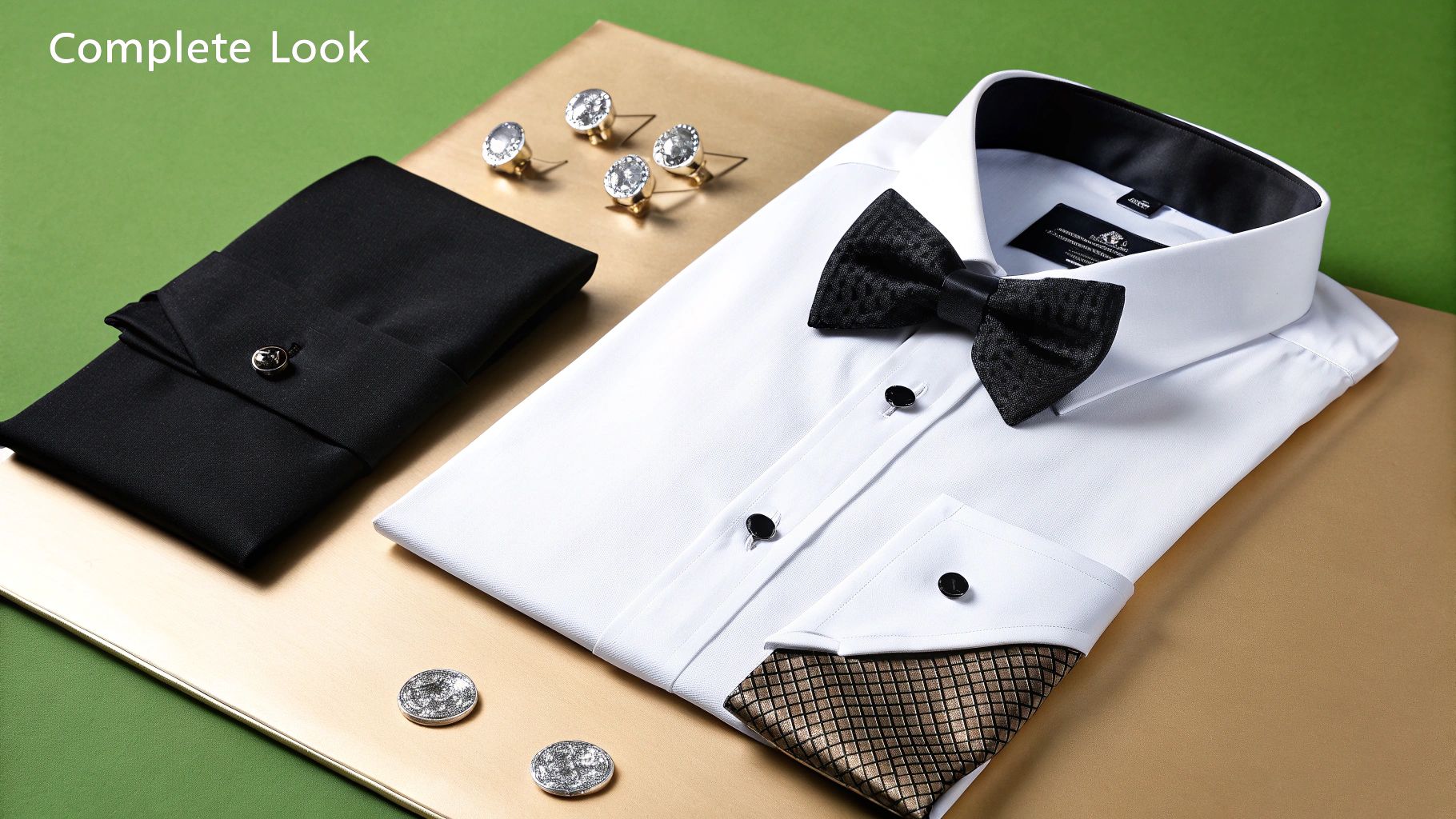
The subtle details are what really separate a standard men's suit from an unforgettable formal look. After you've nailed down the right collar, front, and fabric for your tuxedo bow tie shirt, the final polish comes from the hardware—your cuffs and studs. These small elements are what take your outfit from just good to truly impeccable.
When it comes to a tuxedo shirt, French cuffs are non-negotiable. It’s as simple as that. These longer cuffs fold back on themselves and are secured with cufflinks, adding an essential layer of deliberate style. This is your chance to show some personality. You can go for classic onyx or mother-of-pearl for timeless elegance, or pick something more unique that tells a story.
Coordinating Your Hardware
Here’s a rule to live by: your shirt studs should always match your cufflinks. If you’ve got silver cufflinks, your studs must be silver. It creates a cohesive, intentional look that shows you have a sharp eye for detail. And remember, studs are only used on shirts with a stud placket. If your shirt has a hidden fly front, you won't need them at all.
Pairing these elements correctly with your specific tuxedo is where the real mastery comes in.
- For a classic single-breasted two-piece tuxedo: A pleated front with onyx studs and matching cufflinks is a home run. It reinforces that traditional, sharp feel.
- For a bold double-breasted tuxedo: A clean, plain front shirt is the way to go. You want the jacket's powerful six-button silhouette to do the talking, so simple, elegant cufflinks are all you need.
- For a formal three-piece men's suit: A piqué bib shirt with mother-of-pearl studs adds incredible texture and depth. This level of coordination is especially striking, like what you’d pair with a sharp navy slim fit 3 piece tuxedo.
Tying your own bow tie is the ultimate power move. It has a character and slight, natural imperfection that a pre-tied version can never replicate. A self-tied bow tie is a sign of confidence and a true understanding of the formalwear craft.
By carefully selecting these final pieces, you ensure every part of your outfit works together in perfect harmony, from the buttons on your jacket to the subtle glint of your cufflinks.
Answering Your Tuxedo Shirt Questions
Black-tie rules can feel a little intimidating, but I promise, nailing the details of your tuxedo bow tie shirt is much simpler than it seems. Once you get the hang of a few key elements, you'll be set.
Let's break down some of the most common questions I hear.
Can I Just Wear a Regular White Dress Shirt with My Tuxedo?
You can, but I’d strongly advise against it. A standard dress shirt just isn't built for the job. It’s missing the key features that make a tuxedo shirt, well, a tuxedo shirt—things like a specialized collar and French cuffs.
The barrel cuffs and point collar on your everyday work shirt are designed for a necktie, not a bow tie. Wearing one will instantly bring down the whole look, making your tuxedo feel less like a sharp statement and more like an afterthought, whether you're in a classic two-piece tuxedo or a more formal black slim-fit 3-piece tuxedo.
Pleated vs. Piqué Bib: What's the Real Difference?
This one really boils down to texture and a bit of history.
A pleated bib is what most people picture. It has those thin, vertical pleats running down the front, giving it a very classic, decorative texture. It’s the original, traditional choice for a black-tie men's suit.
A piqué bib, on the other hand, has a stiff front panel woven with a subtle, almost honeycomb-like pattern. It’s just as formal but gives off a more modern, clean-cut vibe. Think of it as the understated cousin to the pleated shirt, perfect for a slim-fit two-piece tuxedo with a single-button closure.
Your choice between a wing tip and a spread collar often comes down to the event's specific dress code and your personal style. The wing tip is the most formal option, while the spread collar offers greater versatility.
Are Shirt Studs an Absolute Must?
Not always! Studs are only necessary if your shirt is specifically designed for them. You'll know because it will have a special stud placket with an extra set of buttonholes where the studs go.
Many modern tuxedo shirts, however, feature a fly front. This is a clever design where a hidden strip of fabric covers the buttons completely, creating an exceptionally clean and minimalist look. With a fly front, studs aren't needed at all. It all comes down to the shirt's construction and how it pairs with the tuxedo, be it a two-piece or three-piece model.


